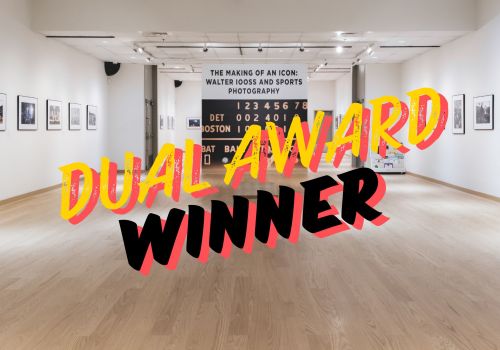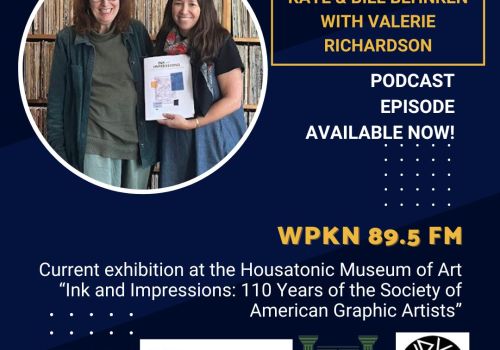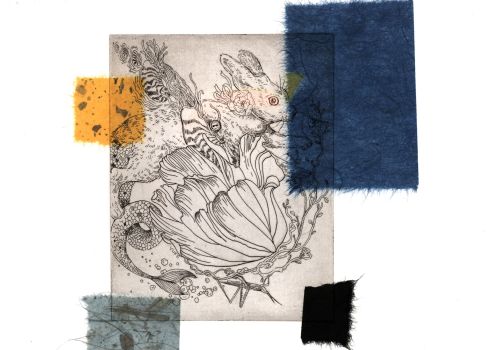
Illustrating Connecticut - Fairfield

|
|
|
Guy Billout Fairfield, Connecticut Hedge Funds, 2006  Watercolor and airbrush, 10 x 8" This drawing illustrated an article in Connecticut Magazine, November 2006, highlighting Greenwich as a leading financial center for hedge funds. Greenwich, one of the most affluent communities in the United States, hosts many hedge funds and other financial services companies that manage an estimated 10 percent of the $1.2 trillion hedge fund investments worldwide. Miggs Burroughs Westport, Connecticut Hi-Ho, 2006 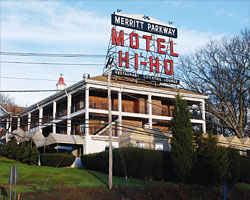 The Merritt Parkway, completed in 1940, is one of the oldest parkways in the United States. The Hi-Ho Motel, located along the Fairfield stretch of highway, reminds us how the need for inexpensive accommodations for automobile travelers generated an entire industry. Kinuko Craft Norfolk, Connecticut The Mystical Helix, 1988 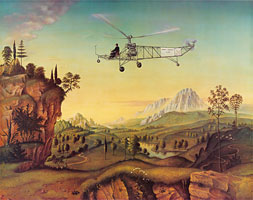 Lithograph, 17 x 21 ¾" The first modern helicopter was designed by Igor Sikorsky (1889-1972) who pilots his steel tube, open-cockpit VS-300 in this piece commissioned by the Associated Aviation Underwriters to honor Sikorsky Aircraft. The experimental aircraft made its first flight on September 14, 1939, and by the summer of 1940, it could stay airborne for 15 minutes. In May 1942, a Sikorsky S-47 or XR-4 was the prototype for the first helicopter produced in quantity for the United States armed forces. The artist portrays Sikorsky over an Italian landscape in tribute to Leonardo da Vinci whose sketches of the first recorded design of a helicopter with a rotating helix inspired the inventor as a youth. Thomas G. Fowler, (1943 - 2006) Westport, Connecticut A Toast to the Millennium, 1999 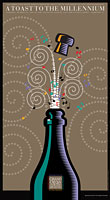 Digital based on a pencil sketch, 15 ¾ x 27 ½" Connecticut is home to many world-class museums, performance groups, and art centers. Pilobolus is recognized as a major American dance company of international influence while the Long Wharf Theater and Hartford Stage are nationally-recognized, Tony-award-winning regional theaters. The Wadsworth Atheneum is the oldest public art museum in the nation, and the Housatonic Museum of Art is the guardian of the largest art collection of any two-year college in New England. The Connecticut Grand Opera & Orchestra, in Stamford, Connecticut, was founded in 1993. The organization fosters the appreciation of operatic and orchestral works through world-class performances and education and outreach programs. This festive poster for the opening of their 1999-2000 season presented something of a dilemma for designer Tom Fowler as the performance it promoted was not an opera per se but an event starring a number of opera greats singing highlights from the Connecticut Grand Opera & Orchestra’s past ten seasons. Typically, his concept would have featured a central character or scene from the production, however, this project required more of a general theme. He explained, "I just wanted to sort of say, ‘Uncorking the season,’ with bubbles and musical notes coming out of the bottle as the cork is popping." Bernie Fuchs Westport, Connecticut Red Barn, 2006 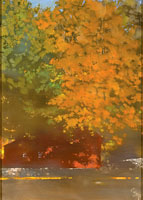 Oil on canvas, 26 x 18" Barns, once a common feature of the Connecticut landscape, are fast disappearing due to neglect and development as farms have been transformed into subdivisions. The function and form of barns have evolved over time. Initially, English barns were erected to store grain and protect livestock. They began to be connected to the family home so work could be performed without having to battle the elements. Ventilated barns and tobacco sheds developed, and finally, the timber-frame structure emerged. The Industrial Revolution affected these structures as well, allowing for standardization, mail order catalog purchase, and easy construction. Mark Hess Katonah, New York Hot Suburbs, c. 1988 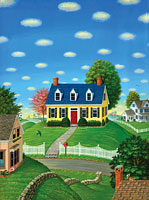 Acrylic on canvas, 16 x 12" Mark Hess recalled his childhood in Greenwich, Connecticut, when he created this New York Magazine cover for their article on the great suburbs in the Tri-State area. Hess noted, the “idealized, simplified, and fun [image] was meant to entice and beautify the lovely features of suburbia in Connecticut.” The iconic stone walls that crisscross the New England landscape are cultural icons that remind us of pre-Industrial Revolution Connecticut with its abundant farms, slower pace, and simpler life. Kathy Jakobsen Michigan; formerly Weston, Connecticut Westport, 1998 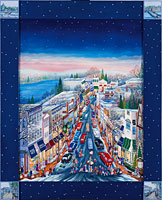 Oil on canvas, 31 ½ x 25 ½" Author, folk artist, and illustrator Kathy Jakobsen painted this illustration for the cover of Westport Magazine. She captured the spirit of the town in her original composition whose blank sky accommodated the magazine’s title as well as in the four corner pieces, which were added later. Westport and Weston have historically been, and continue to be, an enclave for artists drawn to the area’s cultural community and its proximity to New York City. The Westport Historical Society’s records confirm that from 1902 through 1940 more than 160 illustrators worked and lived in Westport alone. In addition, the Famous Artists Schools, founded by Albert Dorne along with Norman Rockwell in 1947, brought another wave of talented illustrators and artists who served on the school’s faculty. Walter O. R. Korder (1891-1962) Hartford, Connecticut Capture of Nathan Hale, c. 1940 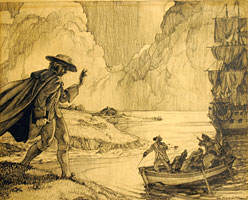 Pencil, 12 x 15" Nathan Hale (1755-76) was born in Coventry, Connecticut, and educated at Yale University. He was a school master before becoming the youngest officer in the Continental Army in 1775, serving as captain during the Revolutionary War. In 1776, he became America’s first spy when he volunteered at the request of General George Washington to cross enemy lines to gather information and to assess the strength of the British Army. He was caught while returning and hung without a trial. An account in a journal by Consider Tiffany, a Tory shopkeeper from Barkhamsted, Connecticut, relates how he was deceived into revealing his identity and mission: “The time being come, Captain Hale repaired to the place agreed on, where he met his pretended friend [British Loyalist, Major Robert Rogers], with three or four men of the same stamp, and after being refreshed, began [a]…conversation. But in the height of their conversation, a company of soldiers surrounded the house, and by orders from the commander, seized Captain Hale in an instant. But denying his name, and the business he came upon, he was ordered to New York. But before he was carried far, several persons knew him and called him by name; upon this he was hanged as a spy, some say, without being brought before a court martial.” The young hero’s last words were, “I only regret that I have but one life to lose for my country.” His patriotism earned him the distinction of State Hero by the Connecticut General Assembly in 1985. |
|

